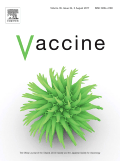View Item
- xmlui.general.dspace_homeCentros e Institutos de InvestigaciónCICVyA. Centro de Investigación en Ciencias Veterinarias y AgronómicasInstituto de BiotecnologíaArtículos científicosxmlui.ArtifactBrowser.ItemViewer.trail
- DSpace Home
- Centros e Institutos de Investigación
- CICVyA. Centro de Investigación en Ciencias Veterinarias y Agronómicas
- Instituto de Biotecnología
- Artículos científicos
- View Item
Evaluation of different heterologous prime-boost immunization strategies against Babesia bovis using viral vectored and protein-adjuvant vaccines based on a chimeric multi-antigen
Abstract
Protection against the intraerythrocytic bovine parasite Babesia bovis requires both humoral and cellular immune responses. Therefore, tailored combinations of immunogens targeted at both arms of the immune system are strategies of choice to pursue sterilizing immunity. In this study, different heterologous prime-boost vaccination schemes were evaluated in mice to compare the immunogenicity induced by a recombinant adenovirus, a modified vaccinia Ankara
[ver mas...]
Protection against the intraerythrocytic bovine parasite Babesia bovis requires both humoral and cellular immune responses. Therefore, tailored combinations of immunogens targeted at both arms of the immune system are strategies of choice to pursue sterilizing immunity. In this study, different heterologous prime-boost vaccination schemes were evaluated in mice to compare the immunogenicity induced by a recombinant adenovirus, a modified vaccinia Ankara vector or a subunit vaccine all expressing a chimeric multi-antigen. This multi-antigen includes the immunodominant B and T cell epitopes of three B. bovis proteins: Merozoite Surface Antigen - 2c (MSA-2c), Rhoptry Associated Protein - 1 (RAP-1) and Heat Shock Protein 20 (HSP20). Both priming with the adenovirus or recombinant multi-antigen and boosting with the modified vaccinia Ankara vector achieved a high degree of activation of TNFα and IFNγ-secreting CD4(+) and CD8(+) specific T cells 60days after the first immunization. High titers of specific IgG antibodies were also detected at the same time point and lasted up to day 120 of the first immunization. Only the adenovirus - MVA combination triggered a marked isotype skew for the IgG2a antibody subclass meanwhile for the other immune traits analyzed here, both vaccination schemes showed similar performances. The immunological characterization in the murine model of these rationally designed immunogens led us to propose that adenoviruses as well as the bacterially expressed multi-antigen are highly reliable primer candidates to be considered in future experiments in cattle to test protection against bovine babesiosis
[Cerrar]

Fuente
Vaccine 34 (33) : 3913-3919. (July 2016)
Date
2016
ISSN
0264-410X
Formato
pdf
Tipo de documento
artículo
Palabras Claves
Derechos de acceso
Restringido
 Excepto donde se diga explicitamente, este item se publica bajo la siguiente descripción: Creative Commons Attribution-NonCommercial-ShareAlike 2.5 Unported (CC BY-NC-SA 2.5)
Excepto donde se diga explicitamente, este item se publica bajo la siguiente descripción: Creative Commons Attribution-NonCommercial-ShareAlike 2.5 Unported (CC BY-NC-SA 2.5)

